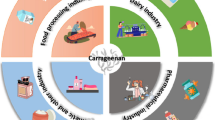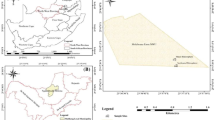Abstract
In recent years, arbuscular mycorrhizal fungi (AMF) have been reported to enhance plant biosynthesis of secondary metabolites with health-promoting activities, such as polyphenols, carotenoids, vitamins, anthocyanins, flavonoids and lycopene. In addition, plant growth-promoting (PGP) bacteria were shown to modulate the concentration of nutraceutical compounds in different plant species. This study investigated for the first time whether genes encoding key enzymes of the biochemical pathways leading to the production of rosmarinic acid (RA), a bioactive compound showing antioxidant, antibacterial, antiviral and anti-inflammatory properties, were differentially expressed in Ocimum basilicum (sweet basil) inoculated with AMF or selected PGP bacteria, by using quantitative real-time reverse transcription PCR. O. basilicum plants were inoculated with either the AMF species Rhizophagus intraradices or a combination of two PGP bacteria isolated from its sporosphere, Sinorhizobium meliloti TSA41 and Streptomyces sp. W43N. Present data show that the selected PGP bacteria were able to trigger the overexpression of tyrosine amino-transferase (TAT), hydroxyphenylpyruvate reductase (HPPR) and p-coumaroyl shikimate 3′-hydroxylase isoform 1 (CS3′H iso1) genes, 5.7-fold, 2-fold and 2.4-fold, respectively, in O. basilicum leaves. By contrast, inoculation with R. intraradices triggered TAT upregulation and HPPR and CS3′H iso1 downregulation. Our data suggest that inoculation with the two selected strains of PGP bacteria utilised here could represent a suitable biotechnological tool to be implemented for the production of O. basilicum plants with increased levels of key enzymes for the biosynthesis of RA, a compound showing important functional properties as related to human health.




Similar content being viewed by others
References
Bais HP, Walker TS, Schweizer HP, Vivanco JA (2002) Root specific elicitation and antimicrobial activity of rosmarinic acid in hairy root cultures of Ocimum basilicum. Plant Physiol Biochem 40:983–99
Baslam M, Garmendia I, Goicoechea N (2011) Arbuscular mycorrhizal fungi (AMF) improved growth and nutritional quality of greenhouse-grown lettuce. J Agric Food Chem 59:5504–5515
Baslam M, Esteban R, García-Plazaola JI, Goicoechea N (2013) Effectiveness of arbuscular mycorrhizal fungi (AMF) for inducing the accumulation of major carotenoids, chlorophylls and tocopherol in green and red leaf lettuces. Appl Microbiol Biotechnol 97:3119–3128
Battini F, Cristani C, Giovannetti M, Agnolucci M (2016) Multifunctionality and diversity of culturable bacterial communities strictly associated with spores of the plant beneficial symbiont Rhizophagus intraradices. Microbiol Res 183:68–79
Blilou I, Ocampo JA, Garcia GJ (2000) Induction of Ltp (lipid transfer protein) and Pal (phenylalanine ammonia-lyase) gene expression in rice roots colonized by the arbuscular mycorrhizal fungus Glomus mosseae. J Exp Bot 51:1969–1977
Bona E, Lingua G, Manassero P, Cantamessa S, Marsano F, Todeschini V, Copetta A, D’Agostino G, Massa N, Avidano L, Gamalero E, Berta G (2014) AM fungi and PGP pseudomonads increase flowering, fruit production, and vitamin content in strawberry grown at low nitrogen and phosphorus levels. Mycorrhiza 25:181–193
Cabanás CGL, Schilirò E, Valverde-Corredor A, Mercado-Blanco J (2014) The biocontrol endophytic bacterium Pseudomonas fluorescens PICF7 induces systemic defense responses in aerial tissues upon colonization of olive roots. Front Microbiol 5:427
Castellanos‐Morales V, Villegas J, Wendelin S, Vierheilig H, Eder R, Cárdenas‐Navarro R (2010) Root colonisation by the arbuscular mycorrhizal fungus Glomus intraradices alters the quality of strawberry fruits (Fragaria × ananassa Duch) at different nitrogen levels. J Sci Food Agric 90:1774–1782
Ceccarelli N, Curadi M, Martelloni L, Sbrana C, Picciarelli P, Giovannetti M (2010) Mycorrhizal colonization impacts on phenolic content and antioxidant properties of artichoke leaves and flower heads two years after field transplant. Plant Soil 335:311–323
Copetta A, Lingua G, Berta G (2006) Effects of three AM fungi on growth, distribution of glandular hairs, and essential oil production in Ocimum basilicum L. var. Genovese. Mycorrhiza 16:485–494
Duthie SJ (2000) Plant polyphenols in cancer and heart disease: implications as nutritional antioxidants. Nut Res Rev 13:79–106
Eberle D, Ullmann P, Werck-Reichhart D, Petersen M (2009) cDNA cloning and functional characterisation of CYP98A14 and NADPH: cytochrome P450 reductase from Coleus blumei involved in rosmarinic acid biosynthesis. Plant Mol Biol 69:239–253
Ehlting J, Hamberger B, Million-Rousseau R, Werck-Reichhart D (2006) Cytochromes P450 in phenolic metabolism. Phytochem Rev 5:239–270
Gang DR, Beuerle T, Ullmann P, Werck-Reichhart D, Pichersky E (2002) Differential production of meta hydroxylated phenylpropanoids in sweet basil peltate glandular trichomes and leaves is controlled by the activities of specific acyltransferases and hydroxylases. Plant Physiol 130:1536–1544
Garcia-Seco D, Zhang Y, Gutierrez-Mañero FJ, Martin C, Ramos-Solano B (2015) Application of Pseudomonas fluorescens to blackberry under field conditions improves fruit quality by modifying flavonoid metabolism. PLoS One 10:e0142639
Giovannetti M, Mosse B (1980) An evaluation of techniques for measuring vesicular–arbuscular mycorrhizal infection in roots. New Phytol 84:489–500
Giovannetti M, Avio L, Barale R, Ceccarelli N, Cristofani R, Iezzi A, Mignolli F, Picciarelli P, Pinto B, Reali D, Sbrana C, Scarpato R (2012) Nutraceutical value and safety of tomato fruits produced by mycorrhizal plants. Br J Nutr 107:242–251
Giovannetti, M, Avio L, Sbrana C (2013) Improvement of nutraceutical value of food by plant symbionts. In Natural Products (pp. 2641–2662). Springer Berlin Heidelberg
Gualandi RJ Jr (2010) Fungal endophytes enhance growth and production of natural products in Echinacea purpurea (Moench.). Dissertation, University of Tennessee, Knoxville
Harrison MJ, Dixon RA (1993) Isoflavonoid accumulation and expression of defense gene transcripts during the establishment of vesicular–arbuscular mycorrhizal associations in root of Medicago truncatula. Mol Plant Microbe In 6:643–654
Hayek S, Gianinazzi-Pearson V, Gianinazzi S, Franken P (2014) Elucidating mechanisms of mycorrhiza-induced resistance against Thielaviopsis basicola via targeted transcript analysis of Petunia hybrida genes. Physiol Mol Plant Pathol 88:67–76
Johnson IT (2007) Phytochemicals and cancer. Proc Nutr Soc 67:207–215
Juliani R, Simon JE (2002) Antioxidant activity of basil. Trends in new crops and new uses. ASHS Press, Alexandria
Lingua G, Bona E, Manassero P, Marsano F, Todeschini V, Cantamessa S, Copetta A, D’Agostino G, Gamalero E, Berta G (2013) Arbuscular mycorrhizal fungi and plant growth-promoting pseudomonads increases anthocyanin concentration in strawberry fruits (Fragaria x ananassa var. Selva) in conditions of reduced fertilization. Int J Mol Sci 14:16207–16225
Livak KJ, Schmittgen TD (2001) Analysis of relative gene expression data using real-time quantitative PCR and the 2−ΔΔCT method. Methods 25:402–408
Lu X, Hao L, Wang F, Huang C, Wu S (2013) Molecular cloning and overexpression of the tyrosine aminotransferase (TAT) gene leads to increased rosmarinic acid yield in Perilla frutescens. Plant Cell Tiss and Org Culture 115:69–83
Matsuno M, Nagatsu A, Ogihara Y, Ellis BE, Mizukami H (2002) CYP98A6 from Lithospermum erythrorhizon encodes 4-coumaroyl-4′-hydroxyphenyllactic acid 3-hydroxylase involved in rosmarinic acid biosynthesis. FEBS Lett 514:219–224
Ordookhani K, Zare M (2011) Effect of Pseudomonas, Azotobacter and arbuscular mycorrhiza fungi on lycopene, antioxidant activity and total soluble solid in tomato (Lycopersicon esculentum F1 Hybrid, Delba). Adv Environ Biol 5:1290–1294
Petersen M (2013) Rosmarinic acid: new aspects. Phytochem Rev 12:207–227
Petersen M, Simmonds MSJ (2003) Rosmarinic acid. Phytochemistry 62:121–125
Petersen M, Abdullah Y, Benner J, Eberle D, Gehlen K, Hücherig S, Janiak V, Kim KH, Sander M, Weitzel C, Wolters S (2009) Evolution of rosmarinic acid biosynthesis. Phytochemistry 70:1663–1679
Rasouli-Sadaghiani M, Hassani A, Barin M, Rezaee Danesh Y, Sefidkon F (2010) Effects of arbuscular mycorrhizal (AM) fungi on growth, essential oil production and nutrients uptake in basil. J Med Plant Res 4:2222–2228
Rather IA, Awasthi P, Mahajan V, Bedi YS, Vishwakarma RA, Gandhi SG (2015) Molecular cloning and functional characterization of an antifungal PR-5 protein from Ocimum basilicum. Gene 558:143–151
Sadat Ejtahed R, Radjabian T, Tafreshi SAH (2015) Expression analysis of phenylalanine ammonia lyase gene and rosmarinic acid production in Salvia officinalis and Salvia virgata shoots under salicylic acid elicitation. Appl Biochem Biotechnol 176:1846–1858
Sikes BA, Kottenie K, Klironomos JN (2009) Plant and fungal identity determines pathogen protection of plant roots by arbuscular mycorrhizas. J Ecol 97:1274–1280
Smith SE, Read DJ (2008) Mycorrhizal symbiosis. Academic Press, Cambridge
Song Z, Li X (2015) Expression profiles of rosmarinic acid biosynthesis genes in two Salvia miltiorrhiza lines with differing water-soluble phenolic contents. Ind Crop Prod 71:24–30
Song J, Wang Z (2009) Molecular cloning, expression and characterization of a phenylalanine ammonia-lyase gene (SmPAL1) from Salvia miltiorrhiza. Mol Biol Rep 36:939–952
Toussaint JP, Smith FA, Smith SE (2007) Arbuscular mycorrhizal fungi can induce the production of phytochemicals in sweet basil irrespective of phosphorus nutrition. Mycorrhiza 17:291–297
Toussaint JP, Kraml M, Nell M, Smith SE, Smith FA, Steinkellner S, Schmiderer C, Vierheilig H, Novak J (2008) Effect of Glomus mosseae on concentrations of rosmarinic and caffeic acids and essential oil compounds in basil inoculated with Fusarium oxysporum f. sp. basilici. Plant Pathol 57:1109–1116
Walter MH, Fester T, Strack D (2000) Arbuscular mycorrhizal fungi induce the non-mevalonate methylerythritol phosphate pathway of isoprenoid biosynthesis correlated with accumulation of the ‘yellow pigment’ and other apocarotenoids. Plant J 21:571–578
Xiao Y, Zhang L, Gao S, Saechao S, Di P, Chen J, Chen W (2011) The c4h, tat, hppr and hppd genes prompted engineering of rosmarinic acid biosynthetic pathway in Salvia miltiorrhiza hairy root cultures. PLoS One 6:e29713
Zhang X, Liu CJ (2015) Multifaceted regulations of gateway enzyme phenylalanine ammonia-lyase in the biosynthesis of phenylpropanoids. Mol Plant 8:17–27
Zubek S, Mielcarek S, Turnau K (2012) Hypericin and pseudohypericin concentrations of a valuable medicinal plant Hypericum perforatum L. are enhanced by arbuscular mycorrhizal fungi. Mycorrhiza 22:149–156
Acknowledgments
This work was funded by a University of Pisa grant (PRA, Progetti di Ricerca di Ateneo).
Author information
Authors and Affiliations
Corresponding author
Additional information
Fabio Battini and Rodolfo Bernardi contributed equally to this work.
Rights and permissions
About this article
Cite this article
Battini, F., Bernardi, R., Turrini, A. et al. Rhizophagus intraradices or its associated bacteria affect gene expression of key enzymes involved in the rosmarinic acid biosynthetic pathway of basil. Mycorrhiza 26, 699–707 (2016). https://doi.org/10.1007/s00572-016-0707-2
Received:
Accepted:
Published:
Issue Date:
DOI: https://doi.org/10.1007/s00572-016-0707-2




